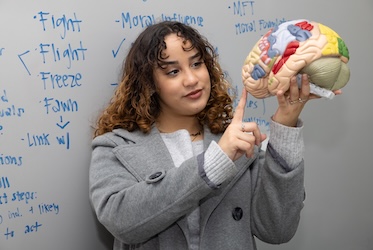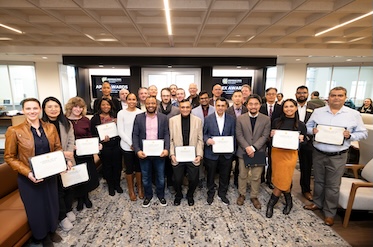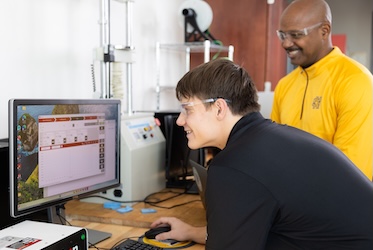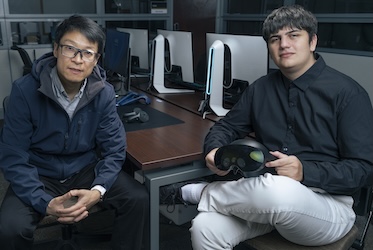

KENNESAW, Ga. | Aug 25, 2020
Five research teams will have the opportunity to pursue new interdisciplinary projects over the next two years as grant recipients of the Interdisciplinary Innovation Initiative (I3) sponsored by the Kennesaw State University Research and Service Foundation (KSURSF).
Spearheaded by Kennesaw State University’s Office of Research, the I3 grants program was created to stimulate innovation, capacity-building and sustainability of interdisciplinary research and scholarly activity around four broad research themes – Biomedical and Health Services, Computing and Technology, Human Development and Well-Being, and Sustainable and Safe Communities.
Each of the five interdisciplinary teams received between $50,000 and $75,000 to address key aspects within these broad themes with the expectation to later seek external funding on their initial work. Undergraduate and graduate students will have the opportunity to engage with faculty as part of the research teams.
“This type of university-wide support demonstrates that Kennesaw State is committed to creating the appropriate infrastructure and culture that facilitates the success of faculty and student scholars in their individual and collaborative work,” KSU President Pamela S. Whitten said.
As the new academic year begins, the I3 scholarly teams will start multi-faceted research inquiries in postpartum health and well-being; microplastics and the environment; preparedness of military trainees; machine learning; and Omega-3 fatty acids for disease prevention.
“Kennesaw State is on an upward trajectory as we have experienced an incredible year of research growth and productivity,” KSU Vice President for Research Phaedra Corso said. “The Office of Research has developed interdisciplinary-focused programming, such as the I3 grants competition, to build a sustainable internal infrastructure to help faculty as they launch collaborative work with the potential to make immediate and impactful discoveries.”
The five teams, made up of KSU faculty, will also include collaboration with external partners. The I3 recipients and projects are:
Georgia has the second highest maternal mortality rate in the U.S., with the postpartum period as the time of highest risk when often unpredictable life-threatening complications can occur. Mothers usually receive information on the warning signs of postpartum complications right after childbirth during the hospital discharge process. The team will measure women’s state of mind associated with stress, arousal and high mental effort during this time to understand how these factors may contribute to the women’s comprehension and long-term retention of this critical postpartum knowledge.
Water and wastewater treatment plants return concentrated amounts of microplastics associated with potential health risks to water bodies and croplands. However, there is no standardized method of analysis for detecting microplastics that may vary in concentrations at different sites, making it impossible to predict the risks of exposure. The team will focus on improving and developing separation mechanisms to better characterize microplastic concentrations and look at how microplastics affect the environment once they are discharged from water treatment plants.
In recent years, military branches have faced an issue in the recruitment and retention of quality personnel, many not finishing initial entry training due to injuries or poor performance. As a result, there are extensive monetary and other factors related to costs associated with training military personnel who do not finish. The primary goal of the study is to examine the fitness, injuries, motivation, and resilience of military base trainees so that appropriate injury prevention strategies can be developed to help military personnel at risk for physical and psychological injuries.
Cyber Physical Social System (CPSS) is a novel paradigm incorporating the physical, cyber and social systems, extending from the Cyber Physical System in which networks and controls were the key components of design such as vehicle collision avoidance. CPSS brings the social dimension to this interaction with machine learning acting as the glue so they all work together. The team plans to develop a prototype of a CPSS that will provide a platform, with the most recent advances in analytics and intelligence technologies, for researchers in non-computing fields to easily integrate into their research activities such as healthcare, exercise science and online education.
Omega-3 fatty acids are long-chain polyunsaturated fatty acids that can be consumed via an oral supplement or eating oily fish such as salmon. Studies in recent decades have identified docosahexaenoic acid (DHA) and eicosapentaenoic acid (EPA) as the particular omega-3 fatty acids responsible in helping prevent cardiovascular disease, stroke, cancer, as well as have the potential to reduce inflammation induced by diseases and exercise. Since many of these studies have examined the combined effects of DHA and EPA, the research team will conduct a comprehensive assessment of the independent effects of DHA and EPA on human health and well-being, including metabolic and cardiovascular health, as well as exercise responses.
—Joëlle Walls

Kennesaw State student explores how trauma affects decision-making

Top researchers recognized for achievements at Apex Awards

Kennesaw State team innovates stronger 3D-printed structures through advanced simulations

Student, faculty researchers explore how AI can improve STEM learning through virtual reality
A leader in innovative teaching and learning, Kennesaw State University offers undergraduate, graduate, and doctoral degrees to its more than 51,000 students. Kennesaw State is a member of the University System of Georgia with 11 academic colleges. The university's vibrant campus culture, diverse population, strong global ties, and entrepreneurial spirit draw students from throughout the country and the world. Kennesaw State is a Carnegie-designated doctoral research institution (R2), placing it among an elite group of only 8 percent of U.S. colleges and universities with an R1 or R2 status. For more information, visit kennesaw.edu.